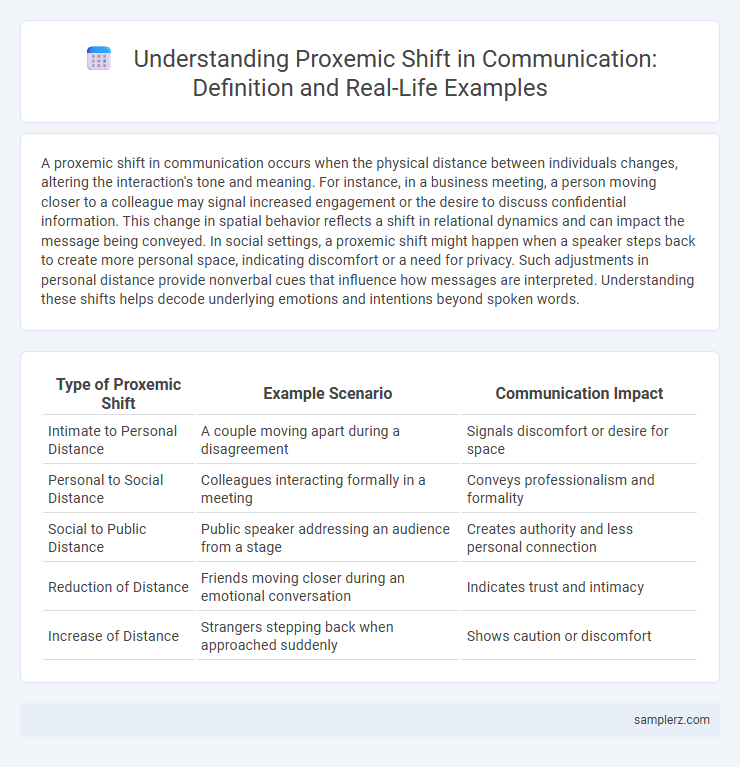A proxemic shift in communication occurs when the physical distance between individuals changes, altering the interaction's tone and meaning. For instance, in a business meeting, a person moving closer to a colleague may signal increased engagement or the desire to discuss confidential information. This change in spatial behavior reflects a shift in relational dynamics and can impact the message being conveyed. In social settings, a proxemic shift might happen when a speaker steps back to create more personal space, indicating discomfort or a need for privacy. Such adjustments in personal distance provide nonverbal cues that influence how messages are interpreted. Understanding these shifts helps decode underlying emotions and intentions beyond spoken words.
Table of Comparison
| Type of Proxemic Shift | Example Scenario | Communication Impact |
|---|---|---|
| Intimate to Personal Distance | A couple moving apart during a disagreement | Signals discomfort or desire for space |
| Personal to Social Distance | Colleagues interacting formally in a meeting | Conveys professionalism and formality |
| Social to Public Distance | Public speaker addressing an audience from a stage | Creates authority and less personal connection |
| Reduction of Distance | Friends moving closer during an emotional conversation | Indicates trust and intimacy |
| Increase of Distance | Strangers stepping back when approached suddenly | Shows caution or discomfort |
Understanding Proxemic Shifts in Communication
Understanding proxemic shifts in communication involves recognizing changes in physical distance that reflect relational dynamics, such as moving closer during intimate conversations or stepping back to establish formality. These shifts signal variations in emotional intensity and social hierarchy, influencing how messages are perceived and interpreted by participants. Effective communication requires sensitivity to these proxemic cues to foster trust, respect, and clarity in interactions.
The Role of Physical Space in Social Interaction
Proxemic shift in communication highlights how changes in physical space influence social interaction dynamics, such as moving from a formal office setting to a casual cafe altering interpersonal distance and comfort levels. In social psychology, Edward T. Hall identified four proxemic zones--intimate, personal, social, and public--each shaping the nature of communication by regulating spatial boundaries. Recognizing proxemic shifts helps improve communication effectiveness by adjusting spatial arrangements to match relational context and cultural norms.
Cultural Influences on Proxemic Behaviors
Cultural influences significantly shape proxemic behaviors, dictating personal space boundaries and physical distance preferences during communication. For example, individuals from Latin American cultures often engage in close interpersonal distances, reflecting warmth and trust, while Northern European cultures typically maintain greater physical space to convey respect and formality. These variations in proxemic norms highlight how cultural context steers nonverbal communication and affects interpersonal interactions globally.
Examples of Proxemic Shifts in Workplace Settings
In workplace settings, proxemic shifts often occur when employees move from individual workstations to collaborative meeting spaces, altering personal distance to foster teamwork and idea exchange. Open-plan offices reduce physical barriers, encouraging closer proxemic proximity that enhances spontaneous communication and collaboration. During virtual meetings, employees experience a digital proxemic shift, relying on screen distance and camera framing to simulate interpersonal space and maintain effective communication cues.
Proxemic Changes in Digital Communication
Proxemic changes in digital communication manifest through the increasing use of virtual meeting platforms where physical distance is replaced by screen-mediated interactions, altering traditional spatial cues. Emoji and reaction icons serve as new proxemic markers, conveying emotional proximity and social presence despite physical separation. This digital proxemic shift redefines interpersonal boundaries and intimacy levels, impacting how individuals negotiate space and connection online.
Personal Space Dynamics in Public Environments
Personal space dynamics in public environments illustrate proxemic shifts where individuals adjust their physical distance based on social norms and situational context, such as standing closer in crowded urban settings compared to more spacious suburban areas. This adaptation affects nonverbal communication cues, influencing comfort levels and social interactions. Understanding these shifts aids in interpreting unspoken messages and navigating social etiquette in diverse public spaces.
Impact of Proxemic Shifts on Interpersonal Relationships
Proxemic shifts, such as changes in physical distance during conversations, significantly influence interpersonal relationships by altering perceived intimacy and comfort levels. When individuals move closer, it often signals trust and emotional connection, whereas increased distance may suggest discomfort or detachment. These nonverbal cues directly affect communication dynamics, shaping relationship development and emotional understanding.
Proxemic Adaptation During Group Discussions
Proxemic adaptation during group discussions often involves adjusting personal space to foster better interaction and understanding among participants. For instance, individuals may unconsciously decrease the distance between themselves and others to signal engagement or increase it to establish boundaries. This dynamic shift in physical proximity enhances communication efficiency and group cohesion by reflecting social cues and comfort levels.
Nonverbal Cues and Proxemic Shifts in Negotiations
Nonverbal cues such as changes in personal distance and body orientation significantly impact proxemic shifts during negotiations, signaling comfort levels and power dynamics. For example, a negotiator leaning forward and reducing physical space may indicate eagerness or assertiveness, while stepping back can communicate discomfort or disagreement. Recognizing these subtle shifts enhances understanding and facilitates more effective communication outcomes in negotiation settings.
Future Trends in Proxemic Communication
Emerging technologies like augmented reality and spatial audio are driving a proxemic shift in communication by enhancing the sense of physical presence in virtual environments. Future trends emphasize personalized spatial interactions where distance and positioning adapt dynamically to social contexts and emotional cues. This evolution enables more natural and immersive communication experiences across remote and hybrid settings.

example of proxemic shift in communication Infographic
 samplerz.com
samplerz.com